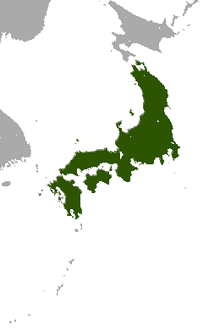Japanese rabbit
| Japanese rabbit | ||||||||||||
|---|---|---|---|---|---|---|---|---|---|---|---|---|

Japanese hare ( Lepus brachyurus ) on Mount Ibuki |
||||||||||||
| Systematics | ||||||||||||
|
||||||||||||
| Scientific name | ||||||||||||
| Lepus brachyurus | ||||||||||||
| Temminck , 1845 |
The Japanese hare ( Lepus brachyurus ) is a species of mammal belonging to the genus of the real hare within the hare-like species . It is endemic to the Japanese islands .
features
The Japanese hare is a relatively small type of hare with a maximum body weight of 2.5 kilograms. In its shape it is particularly similar to the mountain hare ( L. timidus ). The body color is very variable and ranges from a light reddish brown to a dark brownish-gray with variable proportions of white on the head and legs. The northern subspecies have a seasonal dimorphism and change their coat color in winter over several color phases to a white coat.
distribution
The distribution area of the Japanese hare is limited to the Japanese islands of Honshū , Shikoku , Kyushu , Sado , the Oki Islands , Awaji-shima , Shōdoshima , the Gotō Islands and the Amakusa Islands . The species does not occur on Hokkaidō .
As a habitat, the Japanese Hare colonizes various habitats from grasslands to open forest areas and occurs in both flatlands and subalpine regions up to heights of 2,700 meters.
Way of life
The Japanese rabbit is nocturnal and rests all day. In summer it feeds on grasses, which make up 48% of the diet, herbs and crops. In winter it also eats leaves and bark from young trees, especially the sickle fir ( Cryptomeria japonica ), the Japanese maple ( Acer japonicum ), paulownia , acanthopanax , aralia and various legumes .
The mating season extends from February to July and the females give birth to young three to five times a year from April to August. A litter consists of one to four young animals, each weighing around 130 grams. The females reach sexual maturity after about 10 months.
Systematics
The Japanese hare is assigned to the real hare (genus Lepus ) as an independent species . Depending on the source, up to four subspecies are described:
- Lepus brachyurus brachyurus in the southeast of the island of Honshū as well as on Kyushu, Shikoku and other islands
- Lepus brachyurus angustidens in the northwest of the island of Hoshu
- Lepus brachyurus lyoni on Sado
- Lepus brachyurus okiensis in the Oki Islands
Hazard and protection
The Japanese hare is common throughout its range, but population density has decreased in recent years. The total size of the population is unknown, but this has decreased compared to the density in the 1970s and 1980s. It was found that it is greater in young forest stands with herbaceous growth than in older forest stands. Especially on Sado the population goes back due to the hunt and the Japanese marten ( Martes melampus ) introduced there.
The species is classified by the International Union for Conservation of Nature and Natural Resources (IUCN) as not endangered (least concern) due to the size of the population.
supporting documents
- ↑ a b c d e f Joseph A. Chapman, John EC Flux (Ed.): Rabbits, Hares and Pikas. Status Survey and Conservation Action Plan. (PDF file; 10.74 MB) International Union for Conservation of Nature and Natural Resources (IUCN), Gland 1990; P. 69-. ISBN 2-8317-0019-1 .
- ↑ a b c d Lepus brachyurus in the endangered Red List species the IUCN 2011. Posted by: F. Yamada, AT Smith, 2008. Accessed January 25, 2012 Design.
literature
- Joseph A. Chapman, John EC Flux (Eds.): Rabbits, Hares and Pikas. Status Survey and Conservation Action Plan. (PDF file; 10.74 MB) International Union for Conservation of Nature and Natural Resources (IUCN), Gland 1990; Pp. 69-70. ISBN 2-8317-0019-1 .
Web links
- Lepus brachyurus in the endangered Red List species the IUCN 2011. Posted by: F. Yamada, AT Smith, 2008. Accessed January 25, 2012 Design.
